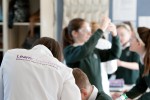
Overwhelmed by the available chemistry resources? Looking for new chemistry teaching ideas? Elementary Articles is the place for chemistry, education, and everything else.
Elementary Articles is the official blog for the RSC's Learn Chemistry – your home for chemistry education resources and activities.
Chemistry and Art!
In each issue, Ionic Magazine will publish recent scientific developments within many areas of science that include medicine, nanotechnology, biotechnology, psychology, astronomy alongside many others. These will be current in the literature, and provide a platform for science writers, whether established in their careers, just beginning or perhaps experimenting their capabilities at science communication, to rant and rave about exciting developments within their particular expertise or interests. Beside each article will lay an artist’s representation of that very story. No graph, no figure, no formulae, instead a piece of art constructed from personal interpretation and not scientific representation. They will leave the reader asking more than can be answered. The ultimate goal: a stunning and stimulating collaboration of two traditionally contrasting worlds.
This edition focuses on the recent developments in RSC journals in the field on scientific and conservation discoveries around various types of art. The stories are deftly told without the technical difficulty of the original paper and the images are intriguing representations of the written content – make of them what you will!
We are also developing new educational content of the chemistry behind art, starting with prehistoric cave paintings all the way through to Impressionism. This will be released in batches throughout the year on Learn Chemistry and eventually all will be presented through our new, coming soon, Chemistry and Art microsite! Cave art coming soon!
Throughout the year departments around the RSC will be tailoring their content to fit with the Chemistry and Art theme. Our Cambridge Science Festival and Big Bang Fair stands will be colour themed, EiC and The Mole will have articles relating to Chemistry and Art (January’s Mole already has the story of the Portrait of Alexander Mornauer) and Chemistry World will have a special issue later this year. Thursday’s monthly public lecture at Burlington House sees Helen Storey and Tony Ryan in conversation discussing their Extreme Collaboration. Sold out, it will be streamed live and available after the event – hopefully on Learn Chemistry too!
Comments